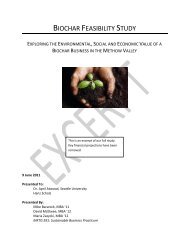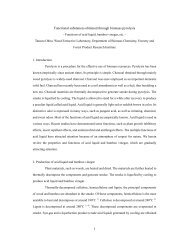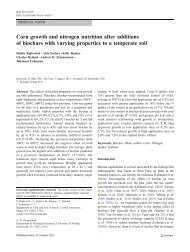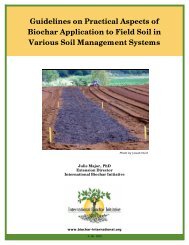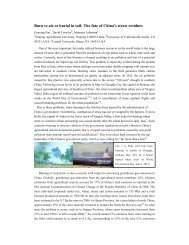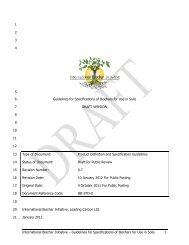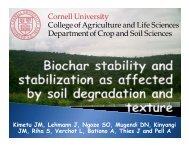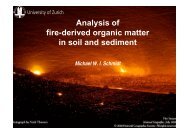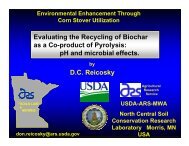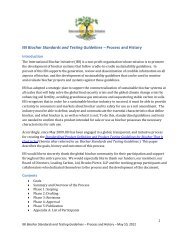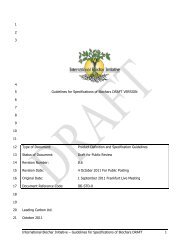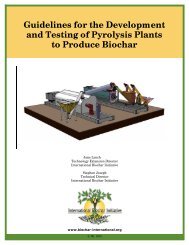Soil priming effects following biochar incorporation - International ...
Soil priming effects following biochar incorporation - International ...
Soil priming effects following biochar incorporation - International ...
Create successful ePaper yourself
Turn your PDF publications into a flip-book with our unique Google optimized e-Paper software.
<strong>Soil</strong> <strong>priming</strong> <strong>effects</strong> <strong>following</strong><br />
<strong>biochar</strong> <strong>incorporation</strong><br />
Yu Luo 1,2 , Mark Durenkamp 1<br />
Qimei Lin 2 and Phil Brookes 1<br />
1<br />
Department of <strong>Soil</strong> Science, Rothamsted Research, Harpenden, UK<br />
2<br />
China Agricultural University, Beijing, China
Carbon sequestration<br />
Biochar<br />
<strong>Soil</strong> Organic C<br />
<strong>Soil</strong> Organic C<br />
<strong>biochar</strong> contributes to<br />
the refractory soil<br />
organic carbon pool<br />
help decrease the<br />
<strong>effects</strong> of global<br />
warming.
The <strong>priming</strong> <strong>effects</strong> <strong>following</strong><br />
substrate addition<br />
CO 2 CO 2<br />
substrate<br />
<strong>Soil</strong> Organic C<br />
soil organic C<br />
mineralisation increased<br />
or decreased by the<br />
addition of organic<br />
substrates.<br />
positive <strong>priming</strong> <strong>effects</strong> (PE).<br />
Negative PE.
The <strong>priming</strong> <strong>effects</strong> <strong>following</strong> <strong>biochar</strong> addition<br />
CO 2 CO 2 CO 2<br />
Biochar C<br />
How about <strong>biochar</strong>?<br />
?<br />
Biochar<br />
<strong>Soil</strong> Organic C<br />
Positive PE may partially<br />
offsets the <strong>effects</strong> of<br />
<strong>biochar</strong> as a long-term<br />
carbon sink in soil<br />
Negative PE could benefit<br />
It still remain poorly understood.
Experimental design<br />
• <strong>Soil</strong>: Hoosfield pH 4 and pH 8<br />
• Biochar: Miscanthus produced at 350 and 700 o C<br />
• Biochar rate: 50 g C kg -1 soil<br />
• Incubation: 90 and 180 days at 40 % Water<br />
Holding Capacity at 25 °C
pH<br />
8.5<br />
7.5<br />
6.5<br />
5.5<br />
4.5<br />
3.5<br />
0 20 40 60 80 100 120 140 160 180 200<br />
Distance (m)<br />
Site: Hoosfield acid strip<br />
HOOSFIELD ACID STRIP<br />
Started more than 100years ago<br />
pH 8.0<br />
pH 5.0<br />
pH 4.0<br />
Organic C (%)<br />
1.05<br />
1.00<br />
0.95<br />
0.90<br />
0.85<br />
0.80<br />
0.75<br />
0.70<br />
0.65<br />
flinty silty clay loam (18-27 % clay)<br />
0 20 40 60 80 100 120 140 160 180 200<br />
Distance (m)
Experimental design<br />
• <strong>Soil</strong>: Hoosfield pH 4 and pH 8<br />
• Biochar: Miscanthus produced at 350 and 700 o C<br />
• Biochar rate: 50 g C kg -1 soil<br />
• Incubation: 90 days at 40 % Water Holding<br />
Capacity at 25 °C
Experimental design<br />
• <strong>Soil</strong>: Hoosfield pH 4 and pH 8<br />
<strong>Soil</strong> Biochar Treatments<br />
pH4 Nil pH4<br />
• Biochar: pH4 Miscanthus BC350 produced at pH4+BC350<br />
and 700 o C<br />
pH4 BC700 pH4+BC700<br />
• Biochar rate: 50 g C kg-1soil<br />
pH8 Nil pH8<br />
pH8 BC350 pH8+BC350<br />
• Incubation: pH8 90 days BC700 at 40 % Water pH8+BC700 Holding<br />
Capacity at 25 °C
soil organic C loss after 90 days<br />
1000<br />
900<br />
800<br />
µg CO 2-C 2 g -1 soil<br />
700<br />
600<br />
500<br />
400<br />
300<br />
?<br />
?<br />
200<br />
100<br />
?<br />
?<br />
0<br />
pH 4 pH 4 +<br />
<strong>biochar</strong><br />
350<br />
pH 4 +<br />
<strong>biochar</strong><br />
700<br />
pH 8 pH 8 +<br />
<strong>biochar</strong><br />
350<br />
pH 8 +<br />
<strong>biochar</strong><br />
700
Quantification of CO 2 evolution<br />
δ 13 C<br />
C3-<strong>Soil</strong> pH 4 -26.579<br />
pH 8 -26.946<br />
C4-Biochar BC350 -12.002<br />
BC700 -12.291<br />
Based on the different stable isotope composition<br />
(represented as δ 13 C value), the percentage of CO 2 -C<br />
from C4 plant can be known by determining the carbon<br />
isotopic composition after <strong>incorporation</strong> of new C4<br />
vegetation C in C3 SOM pools.
Quantification of CO 2 evolution<br />
µg CO 2-C 2 g -1 soil<br />
900<br />
800<br />
700<br />
600<br />
500<br />
400<br />
300<br />
200<br />
100<br />
soil-derived CO2<br />
<strong>biochar</strong>-derived CO2<br />
PE<br />
PE<br />
PE<br />
PE<br />
0<br />
pH 4 pH 4 +<br />
<strong>biochar</strong><br />
350<br />
pH 4 +<br />
<strong>biochar</strong><br />
700<br />
pH 8 pH 8 +<br />
<strong>biochar</strong><br />
350<br />
pH 8 +<br />
<strong>biochar</strong><br />
700
The <strong>Soil</strong> organic C loss caused by the <strong>priming</strong> <strong>effects</strong> offsets<br />
the positive <strong>effects</strong> of <strong>biochar</strong> on carbon sequestration<br />
But…
This loss will be more than compensated<br />
CO 2 CO 2<br />
by <strong>biochar</strong> <strong>incorporation</strong><br />
CO2<br />
Biochar C<br />
<strong>biochar</strong> loss<br />
SOC loss<br />
<strong>Soil</strong> Organic C<br />
<strong>Soil</strong><br />
<strong>Soil</strong><br />
Organic<br />
Organic C<br />
<strong>Soil</strong> Organic C<br />
With <strong>biochar</strong><br />
Without <strong>biochar</strong>
Organic C in soil after 90 days<br />
7<br />
6<br />
% of C in<br />
soil<br />
5<br />
4<br />
3<br />
2<br />
1<br />
0<br />
pH 4 pH 4 +<br />
BC350<br />
pH 4 +<br />
BC700<br />
pH 8 pH 8 +<br />
BC350<br />
pH 8 +<br />
BC700
Unpyrolyzed<br />
biomass<br />
CO 2 CO 2<br />
CO 2 CO 2<br />
pyrolyzed<br />
<strong>biochar</strong><br />
?<br />
<strong>Soil</strong> Organic C<br />
<strong>Soil</strong> Organic C<br />
With pyrolysis<br />
Without pyrolysis
Short conclusion<br />
• Biochar caused <strong>priming</strong> effect, especially with <strong>biochar</strong>350, thus,<br />
partially offsets the positive <strong>effects</strong> of <strong>biochar</strong> on carbon<br />
sequestration<br />
• Priming <strong>effects</strong> caused by Miscanthus <strong>biochar</strong> might be smaller<br />
than non-pyrolysed Miscanthus. Also, this C loss might be more<br />
than compensated. Both needs further research.
Correlation between soil organic C mineralisation<br />
and <strong>biochar</strong> mineralisation<br />
Interactive increased mineralisation between added <strong>biochar</strong> and soil organic C<br />
was explained as microbial co-metabolism
iological<br />
<strong>Soil</strong> Organic C<br />
Biochar
<strong>Soil</strong> ATP after 90 days<br />
ATP nmol g-1 soil<br />
5<br />
4<br />
3<br />
2<br />
1<br />
pH 4<br />
5<br />
4<br />
3<br />
2<br />
1<br />
pH 8<br />
0<br />
0
<strong>Soil</strong> microbial biomass<br />
200<br />
pH 4<br />
200<br />
pH 8<br />
Microbial biomass C<br />
(µg C g- -1 soil)<br />
150<br />
100<br />
50<br />
150<br />
100<br />
50<br />
0<br />
O 350 700<br />
0<br />
O 350 700<br />
BC350 increase biomass but BC700 doesn’t change<br />
All data represent the mean of 3 replicates +/- SE
Microbial colonization in pH high soil<br />
+BC350<br />
+BC700
Water Extractable Organic Carbon and Nitrogen
Biochar <strong>incorporation</strong> into Biomass<br />
30<br />
25<br />
20<br />
15<br />
10<br />
5<br />
pH4 pH8<br />
<strong>biochar</strong> derived<br />
microbial biomass (%)<br />
BC700 in<br />
pH4 soil<br />
0<br />
O + BC350 O + BC700
iological<br />
<strong>Soil</strong> Organic C<br />
Biochar<br />
Physicochemical
<strong>Soil</strong> acid properties<br />
K 2 SO 4<br />
extractable Al<br />
K 2 SO 4<br />
extractable Mn<br />
Treatments<br />
<strong>Soil</strong>s<br />
pH<br />
(µg g -1 soil)<br />
(µg g -1 soil)<br />
O Low pH 3.73 (0.02) 540.41 (5.27) 66.30 (1.30)<br />
High pH 7.47 (0.03) 6.63 (2.84) DD<br />
O+<strong>biochar</strong>350 Low pH 4.41 (0.03) 265.12 (18.0) 105.66 (2.64)<br />
High pH 7.70 (0.02) 3.82 (1.50) DD<br />
O+<strong>biochar</strong>700 Low pH 5.14 (0.01) 203.98 (10.9) 7.40 (0.07)<br />
High pH 8.06 (0.02) 2.92 (2.12) DD
The mechanisms of short term PE<br />
It may caused by the activated soil microorganisms<br />
through:<br />
Food--labile organic C and nutrient availability<br />
House—large surface area<br />
Better environment--Liming effect
iological<br />
<strong>Soil</strong><br />
charsphere<br />
Biochar<br />
Physicchemical
1. Large surface area<br />
2. available C and nutrient<br />
3. Water<br />
4. Temperature<br />
5. Aeration<br />
6. Liming effect<br />
Microorganisms<br />
<strong>Soil</strong> Organic C<br />
Root<br />
Added OM
Conclusion<br />
Biochar caused short term <strong>priming</strong> effect, especially with <strong>biochar</strong>350<br />
The soil organic C loss or surplus with the addition of <strong>biochar</strong> needs<br />
further investigation.<br />
The <strong>priming</strong> <strong>effects</strong> were most probably caused by the activated soil<br />
microorganisms through the water soluble components of the<br />
<strong>biochar</strong>, or by others, like, surface area, liming <strong>effects</strong>.<br />
The interaction between different organic C in the charsphere<br />
requires further investigation
Acknowledgements<br />
Jean Devonshire<br />
Wendy Wilmer<br />
Anne Duffy<br />
Martina Masna<br />
-Rothamsted Research, Harpenden, UK<br />
Guitong Li<br />
Xiaorong Zhao<br />
Tao Ma<br />
-China Agricultural University, Beijing, China<br />
CSC funding
The mechanisms of short term PE<br />
Caused by the activated soil microorganisms through:<br />
Food--labile organic C and nutrient availability<br />
House—large surface area<br />
Better environment--Liming effect<br />
Also, possibly, advanced home appliances<br />
a) air conditioner (aeration)<br />
b) Humidifier (moisture)<br />
c) heater (albedo)
appendix<br />
13 C Calculation<br />
ATP,<br />
biomass, methodology
The standard equation for determining δ 13 C (‰) is derived from:<br />
δ 13 C (‰) = [(R sample /R VPDB ) – 1] × 1000, Eqn. 1<br />
where R sample is the mass ratio of 13 C to 12 C and R VPDB is the international PDB<br />
limestone standard.<br />
The labelled 13 C (%) was then estimated from:<br />
CO 2 - 13 C (%) = (δ treatment - δC3) / (δC4 - δC3), Eqn. 2<br />
where CO 2 - 13 C (%) is the proportion of evolved CO 2 from C4 (Miscanthus <strong>biochar</strong>)<br />
materials, δ treatment is the δ 13 C (‰) in treatment, δC3 is the δ 13 C (‰) in control soil<br />
and δC4 is the δ 13 C (‰) from C4 (Miscanthus <strong>biochar</strong>) materials.<br />
Thus, the CO 2 -C produced by <strong>biochar</strong> during the incubation was calculated from:<br />
CO 2 - 13 C (μg g -1 soil) = CO 2 - 13 C (%) × total evolved CO 2 -C (μg g -1 soil) Eqn. 3
The absolute <strong>priming</strong> effect (or primed soil CO 2 -C) with the addition of <strong>biochar</strong> was<br />
calculated from:<br />
Primed soil CO 2 -C (µg C g -1 soil) = CO 2 -C treatment - CO 2 -C control , Eqn. 4<br />
where CO 2 -C treatment is the non-isotopically labelled CO 2 -C evolved from <strong>biochar</strong><br />
amended soil, CO 2 -C control is non-isotopically labelled CO 2 -C evolved from control.<br />
The <strong>priming</strong> effect of soil organic C, expressed as the % increase compared to CO 2 -<br />
C evolved from the control was calculated from:<br />
Priming effect (%) = 100 × (CO 2 -C treatment - CO 2 -C control ) / CO 2 -C control Eqn. 5
Plants possessing the C3 pathway have δ 13 C<br />
values with a mean of –27‰.<br />
Plant with C4 photosynthesis discriminate less<br />
Plant with C4 photosynthesis discriminate less<br />
against 13 CO 2 , thus have greater δ 13 C values<br />
than C3 plants, with a mean of –13‰.
<strong>Soil</strong> microbial biomass--ATP<br />
An independent measure of soil microbial<br />
biomass<br />
Only present in living cells<br />
Linearly related to soil microbial biomass C<br />
May be accurately and precisely extracted<br />
from soil and measured by firefly luciferin –<br />
luciferase reagent.
ATP concentration of microbial biomass<br />
10.4 µmoles ATP g -1 biomass C (n=207)<br />
Contin<br />
et al.<br />
(2001)
ERROR: syntaxerror<br />
OFFENDING COMMAND: --nostringval--<br />
STACK:<br />
86<br />
14042<br />
1



